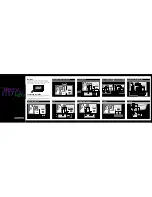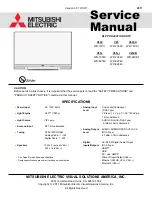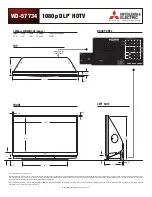
3
1 Safety Precautions
1.1.
General Guidelines
1. When conducting repairs and servicing, do not attempt to modify the equipment, its parts or its materials.
2. When wiring units (with cables, flexible cables or lead wires) are supplied as repair parts and only one wire or some of the
wires have been broken or disconnected, do not attempt to repair or re-wire the units. Replace the entire wiring unit instead.
3. When conducting repairs and servicing, do not twist the Fasten connectors but plug them straight in or unplug them straight
out.
4. When servicing, observe the original lead dress. If a short circuit is found, replace all parts which have been overheated or
damaged by the short circuit.
5. After servicing, see to it that all the protective devices such as insulation barriers, insulation papers shields are properly
installed.
6. After servicing, make the following leakage current checks to prevent the customer from being exposed to shock hazards.
1.1.1.
Leakage Current Cold Check
1. Unplug the AC cord and connect a jumper between the
two prongs on the plug.
2. Measure the resistance value, with an ohmmeter,
between the jumpered AC plug and each exposed
metallic cabinet part on the equipment such as
screwheads, connectors, control shafts, etc. When the
exposed metallic part has a return path to the chassis, the
reading should be between 1Mohm and 5.2Mohm.
When the exposed metal does not have a return path to
the chassis, the reading must be
.
1.1.2.
Leakage Current Hot Check (See
Figure 1.)
1. Plug the AC cord directly into the AC outlet. Do not use
an isolation transformer for this check.
2. Connect a 1.5kohm, 10 watts resistor, in parallel with a
0.15
μ
F capacitors, between each exposed metallic part
on the set and a good earth ground such as a water pipe,
as shown in Figure 1.
3. Use an AC voltmeter, with 1000 ohms/volt or more
sensitivity, to measure the potential across the resistor.
4. Check each exposed metallic part, and measure the
voltage at each point.
5. Reverse the AC plug in the AC outlet and repeat each of
the above measurements.
6. The potential at any point should not exceed 0.75 volts
RMS. A leakage current tester (Simpson Model 229 or
equivalent) may be used to make the hot checks, leakage
current must not exceed 1/2 milliamp. In case a
measurement is outside of the limits specified, there is a
possibility of a shock hazard, and the equipment should
be repaired and rechecked before it is returned to the
customer.
Figure 1
Summary of Contents for Viera TC-P50U50
Page 30: ...30 ...
Page 32: ...32 11 3 Wiring 2 ...
Page 33: ...33 11 4 Wiring 3 ...
Page 34: ...34 11 5 Wiring 4 11 6 Wiring 5 ...
Page 35: ...Model No TC P50U50 Schematic Diagram Note S 1 ...
Page 36: ...Model No TC P50U50 Replacement Parts List Note S 2 ...
Page 37: ...Model No TC P50U50 A Board 1 14 S 3 ...
Page 38: ...Model No TC P50U50 A Board 2 14 S 4 ...
Page 39: ...Model No TC P50U50 A Board 3 14 S 5 ...
Page 40: ...Model No TC P50U50 A Board 4 14 S 6 ...
Page 41: ...Model No TC P50U50 A Board 5 14 and K Board S 7 ...
Page 42: ...Model No TC P50U50 A Board 6 14 S 8 ...
Page 43: ...Model No TC P50U50 A Board 7 14 S 9 ...
Page 44: ...Model No TC P50U50 A Board 8 14 S 10 ...
Page 45: ...Model No TC P50U50 A Board 9 14 S 11 ...
Page 46: ...Model No TC P50U50 A Board 10 14 S 12 ...
Page 47: ...Model No TC P50U50 A Board 11 14 S 13 ...
Page 48: ...Model No TC P50U50 A Board 12 14 S 14 ...
Page 49: ...Model No TC P50U50 A Board 13 14 S 15 ...
Page 50: ...Model No TC P50U50 A Board 14 14 S 16 ...
Page 51: ...Model No TC P50U50 C1 Board 1 2 S 17 ...
Page 52: ...Model No TC P50U50 C1 Board 2 2 S 18 ...
Page 53: ...Model No TC P50U50 C2 Board 1 2 S 19 ...
Page 54: ...Model No TC P50U50 C2 Board 2 2 S 20 ...
Page 55: ...Model No TC P50U50 C3 Board 1 2 S 21 ...
Page 56: ...Model No TC P50U50 C3 Board 2 2 S 22 ...
Page 57: ...Model No TC P50U50 SC Board 1 2 S 23 ...
Page 58: ...Model No TC P50U50 SC Board 2 2 S 24 ...
Page 59: ...Model No TC P50U50 SS Board 1 2 S 25 ...
Page 60: ...Model No TC P50U50 SS Board 2 2 S 26 ...
Page 61: ...Model No TC P50U50 A Board Foil side S 27 ...
Page 62: ...Model No TC P50U50 A Board Component side S 28 ...
Page 63: ...Model No TC P50U50 K Board S 29 ...
Page 64: ...Model No TC P50U50 C1 Board S 30 ...
Page 65: ...Model No TC P50U50 C2 Board S 31 ...
Page 66: ...Model No TC P50U50 C3 Board S 32 ...
Page 67: ...Model No TC P50U50 SC Board S 33 ...
Page 68: ...Model No TC P50U50 SS Board S 34 ...
Page 90: ...Model No TC P50U50 Exploded View 1 S 56 ...
Page 91: ...Model No TC P50U50 Exploded View 2 S 57 ...































